一、获取Bean
第一阶段获取Bean
这里的流程图的入口在 AbstractBeanFactory类的 doGetBean方法,这里可以配合前面的 getBean方法分析文章进行阅读。主要流程就是
1、先处理Bean 的名称,因为如果以“&”开头的Bean名称表示获取的是对应的FactoryBean对象;
2、从缓存中获取单例Bean,有则进一步判断这个Bean是不是在创建中,如果是的就等待创建完毕,否则直接返回这个Bean对象
3、如果不存在单例Bean缓存,则先进行循环依赖的解析
4、解析完毕之后先获取父类BeanFactory,获取到了则调用父类的getBean方法,不存在则先合并然后创建Bean
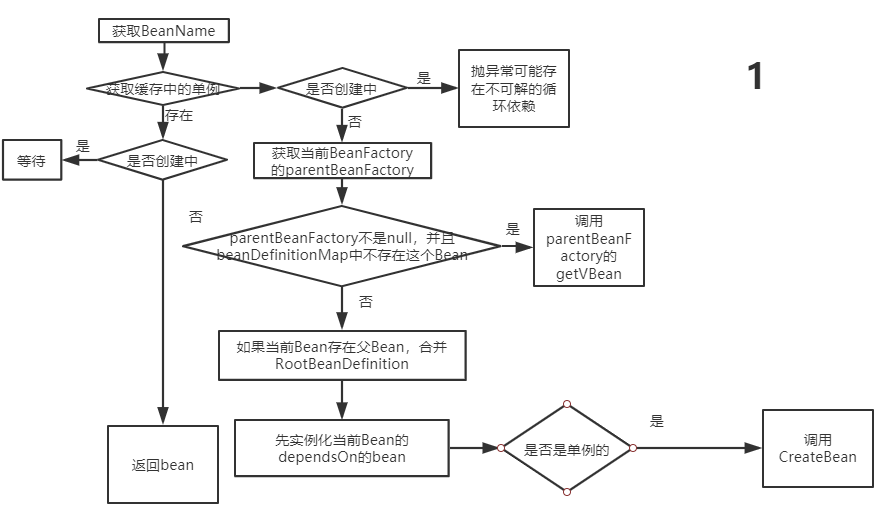
二、创建Bean
创建Bean之前

在真正创建Bean之前逻辑
这个流程图对应的代码在 AbstractAutowireCapableBeanFactory类的 createBean方法中。
1、这里会先获取 RootBeanDefinition对象中的Class对象并确保已经关联了要创建的Bean的Class 。
2、这里会检查3个条件
(1)Bean的属性中的 beforeInstantiationResolved字段是否为true,默认是false。
(2)Bean是原生的Bean
(3)Bean的 hasInstantiationAwareBeanPostProcessors属性为true,这个属性在Spring准备刷新容器钱转杯BeanPostProcessors的时候会设置,如果当前Bean实现了 InstantiationAwareBeanPostProcessor则这个就会是true。
当三个条件都存在的时候,就会调用实现的 InstantiationAwareBeanPostProcessor接口的 postProcessBeforeInstantiation方法,然后获取返回的Bean,如果返回的Bean不是null还会调用实现的 BeanPostProcessor接口的 postProcessAfterInitialization方法,这里用代码说明
1
2
3
4
5
6
7
8
9
10
11
12
13
14
15
16
17
18
19
20
21
22
| protected Object resolveBeforeInstantiation(String beanName,RootBeanDefinition mbd) {
Object bean = null;
if(! Boolean.FALSE.equals(mbd.beforeInstantiationResolved)) {
if(!mbd.isSynthetic() && hasInstantiationAwareBeanPostProcessors()) {
Class<?> targetType = determineTargetType(beanName, mbd);
if(targetType != null) {
bean = applyBeanPostProcessorsBeforeInstantiation(targetType, beanName);
if(bean != null ) {
bean = applyBeanPostProcessorsAfterInitialization(bean, beanName);
}
}
}
mbd.beforeInstantiationResolved = (bean != null);
}
return bean;
}
|
如果上面3个条件其中一个不满足就不会调用实现的方法。默认这里都不会调用的这些 BeanPostProcessors的实现方法。然后继续执行后面的 doCreateBean方法。
真正的创建Bean,doCreateBean
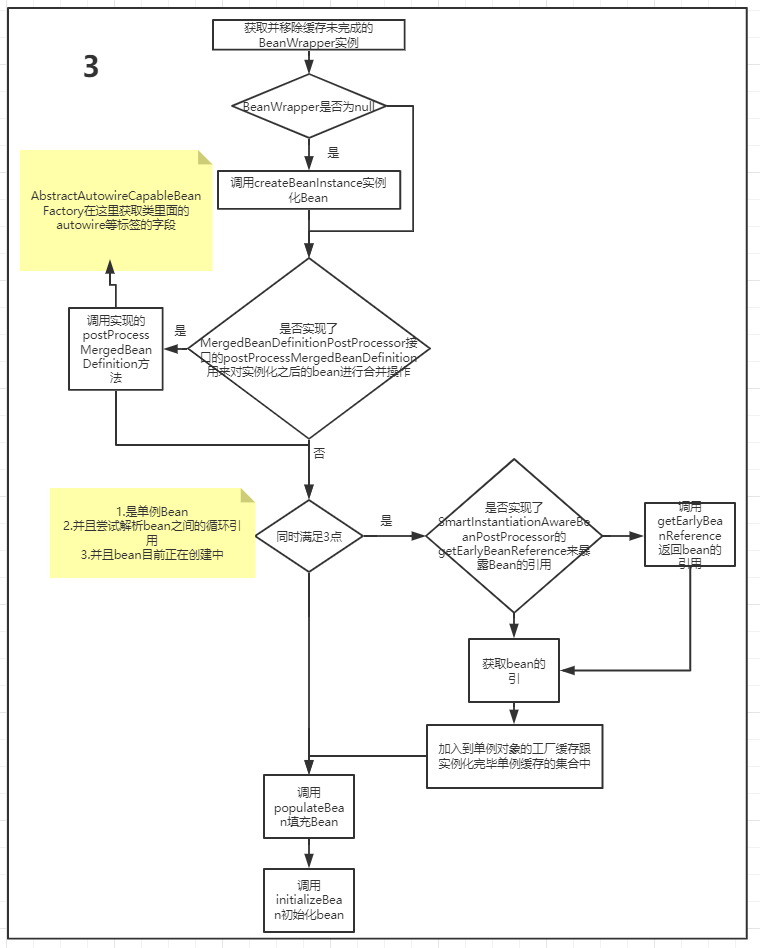
doCreateBean方法逻辑
这个代码的实现还是在 AbstractAutowireCapableBeanFactory方法中。流程是
1、先检查 instanceWrapper变量是不是null,这里一般是null,除非当前正在创建的Bean在 factoryBeanInstanceCache中存在这个是保存还没创建完成的FactoryBean的集合。
2、调用createBeanInstance方法实例化Bean,这个方法在后面会讲解
3、如果当前 RootBeanDefinition对象还没有调用过实现了的 MergedBeanDefinitionPostProcessor接口的方法,则会进行调用 。
4、 当满足以下三点
(1)是单例Bean
(2)尝试解析bean之间的循环引用
(3)bean目前正在创建中
则会进一步检查是否实现了 SmartInstantiationAwareBeanPostProcessor接口如果实现了则调用是实现的 getEarlyBeanReference方法5、 调用 populateBean方法进行属性填充,这里后面会讲解6、 调用 initializeBean方法对Bean进行初始化,这里后面会讲解
实例化Bean,createBeanInstance

实例化Bean
这里的逻辑稍微有一点复杂,这个流程图已经是简化过后的了。简要根据代码说明一下流程
1
2
3
4
5
6
7
8
9
10
11
12
13
14
15
16
17
18
19
20
21
22
23
24
25
26
27
| protected BeanWrapper createBeanInstance(String beanName, RootBeanDefinition mbd, Object[] args) {
Class<?> beanClass = this.resolveBeanClass(mbd, beanName, new Class[0]);
if (beanClass != null && !Modifier.isPublic(beanClass.getModifiers()) && !mbd.isNonPublicAccessAllowed()) {
throw new BeanCreationException(mbd.getResourceDescription(), beanName, "Bean class isn't public, and non-public access not allowed: " + beanClass.getName());
} else if (mbd.getFactoryMethodName() != null) {
return this.instantiateUsingFactoryMethod(beanName, mbd, args);
} else {
boolean resolved = false;
boolean autowireNecessary = false;
if (args == null) {
Object var7 = mbd.constructorArgumentLock;
synchronized(mbd.constructorArgumentLock) {
if (mbd.resolvedConstructorOrFactoryMethod != null) {
resolved = true;
autowireNecessary = mbd.constructorArgumentsResolved;
}
}
}
if (resolved) {
return autowireNecessary ? this.autowireConstructor(beanName, mbd, (Constructor[])null, (Object[])null) : this.instantiateBean(beanName, mbd);
} else {
Constructor<?>[] ctors = this.determineConstructorsFromBeanPostProcessors(beanClass, beanName);
return ctors == null && mbd.getResolvedAutowireMode() != 3 && !mbd.hasConstructorArgumentValues() && ObjectUtils.isEmpty(args) ? this.instantiateBean(beanName, mbd) : this.autowireConstructor(beanName, mbd, ctors, args);
}
}
}
|
1、先检查Class是否已经关联了,并且对应的修饰符是否是public的
2、如果用户定义了Bean实例化的函数,则调用并返回
3、如果当前Bean实现了 FactoryBean接口则调用对应的 FactoryBean接口的 getObject方法
4、根据getBean时候是否传入构造参数进行处理
4.1 如果没有传入构造参数,则检查是否存在已经缓存的无参构造器,有则使用构造器直接创建,没有就会调用 instantiateBean方法先获取实例化的策略默认是 CglibSubclassingInstantiationStrategy,然后实例化Bean。最后返回
4.2 如果传入了构造参数,则会先检查是否实现了 SmartInstantiationAwareBeanPostProcessor接口,如果实现了会调用 determineCandidateConstructors获取返回的候选构造器。
4.3 检查4个条件是否满足一个
(1)构造器不为null,
(2)从RootBeanDefinition中获取到的关联的注入方式是构造器注入(没有构造参数就是setter注入,有则是构造器注入)
(3)含有构造参数
(4)getBean方法传入构造参数不是空
满足其中一个则会调用返回的候选构造器实例化Bean并返回,如果都不满足,则会根据构造参数选则合适的有参构造器然后实例化Bean并返回
5、如果上面都没有合适的构造器,则直接使用无参构造器创建并返回Bean。
填充Bean,populateBean
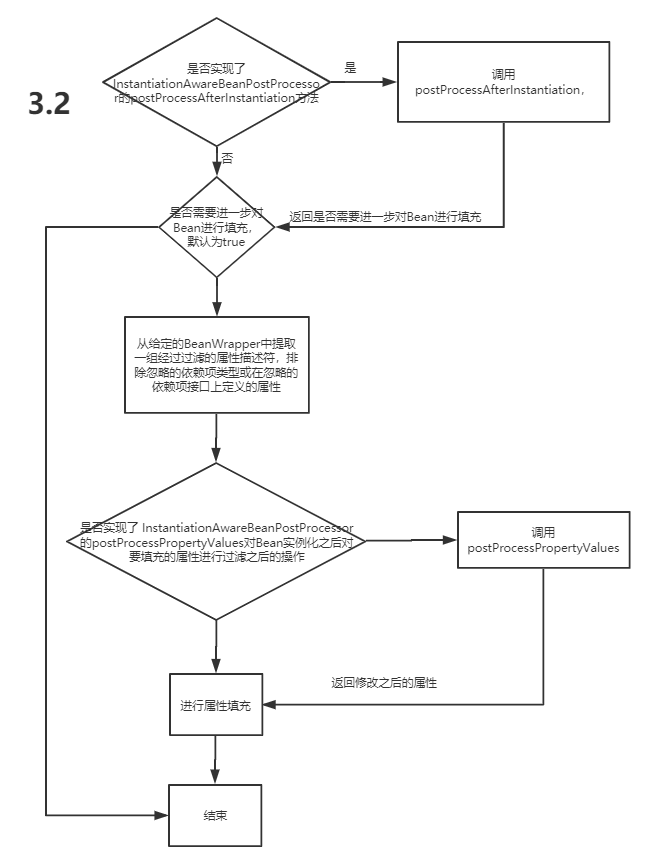
填充Bean
这里还是根据代码来说一下流程
1
2
3
4
5
6
7
8
9
10
11
12
13
14
15
16
17
18
19
20
21
22
23
24
25
26
27
28
29
30
31
32
33
34
35
36
37
38
39
40
41
42
43
44
45
46
47
48
49
50
51
52
53
54
55
56
57
58
59
60
61
62
63
64
65
| protected void populateBean(String beanName, RootBeanDefinition mbd, BeanWrapper bw) {
PropertyValues pvs = mbd.getPropertyValues();
if (bw == null) {
if (!((PropertyValues)pvs).isEmpty()) {
throw new BeanCreationException(mbd.getResourceDescription(), beanName, "Cannot apply property values to null instance");
}
} else {
boolean continueWithPropertyPopulation = true;
if (!mbd.isSynthetic() && this.hasInstantiationAwareBeanPostProcessors()) {
Iterator var6 = this.getBeanPostProcessors().iterator();
while(var6.hasNext()) {
BeanPostProcessor bp = (BeanPostProcessor)var6.next();
if (bp instanceof InstantiationAwareBeanPostProcessor) {
InstantiationAwareBeanPostProcessor ibp = (InstantiationAwareBeanPostProcessor)bp;
if (!ibp.postProcessAfterInstantiation(bw.getWrappedInstance(), beanName)) {
continueWithPropertyPopulation = false;
break;
}
}
}
}
if (continueWithPropertyPopulation) {
if (mbd.getResolvedAutowireMode() == 1 || mbd.getResolvedAutowireMode() == 2) {
MutablePropertyValues newPvs = new MutablePropertyValues((PropertyValues)pvs);
if (mbd.getResolvedAutowireMode() == 1) {
this.autowireByName(beanName, mbd, bw, newPvs);
}
if (mbd.getResolvedAutowireMode() == 2) {
this.autowireByType(beanName, mbd, bw, newPvs);
}
pvs = newPvs;
}
boolean hasInstAwareBpps = this.hasInstantiationAwareBeanPostProcessors();
boolean needsDepCheck = mbd.getDependencyCheck() != 0;
if (hasInstAwareBpps || needsDepCheck) {
PropertyDescriptor[] filteredPds = this.filterPropertyDescriptorsForDependencyCheck(bw, mbd.allowCaching);
if (hasInstAwareBpps) {
Iterator var9 = this.getBeanPostProcessors().iterator();
while(var9.hasNext()) {
BeanPostProcessor bp = (BeanPostProcessor)var9.next();
if (bp instanceof InstantiationAwareBeanPostProcessor) {
InstantiationAwareBeanPostProcessor ibp = (InstantiationAwareBeanPostProcessor)bp;
pvs = ibp.postProcessPropertyValues((PropertyValues)pvs, filteredPds, bw.getWrappedInstance(), beanName);
if (pvs == null) {
return;
}
}
}
}
if (needsDepCheck) {
this.checkDependencies(beanName, mbd, filteredPds, (PropertyValues)pvs);
}
}
this.applyPropertyValues(beanName, mbd, bw, (PropertyValues)pvs);
}
}
}
|
1、检查当前Bean是否实现了 InstantiationAwareBeanPostProcessor的 postProcessAfterInstantiation方法则调用,并结束Bean的填充。
2、将按照类型跟按照名称注入的Bean分开,如果注入的Bean还没有实例化的这里会实例化,然后放到 PropertyValues对象中。
3、如果实现了 InstantiationAwareBeanPostProcessor类的 postProcessProperties则调用这个方法并获取返回值,如果返回值是null,则有可能是实现了过期的 postProcessPropertyValues方法,这里需要进一步调用 postProcessPropertyValues方法
4、进行参数填充
初始化Bean,initializeBean
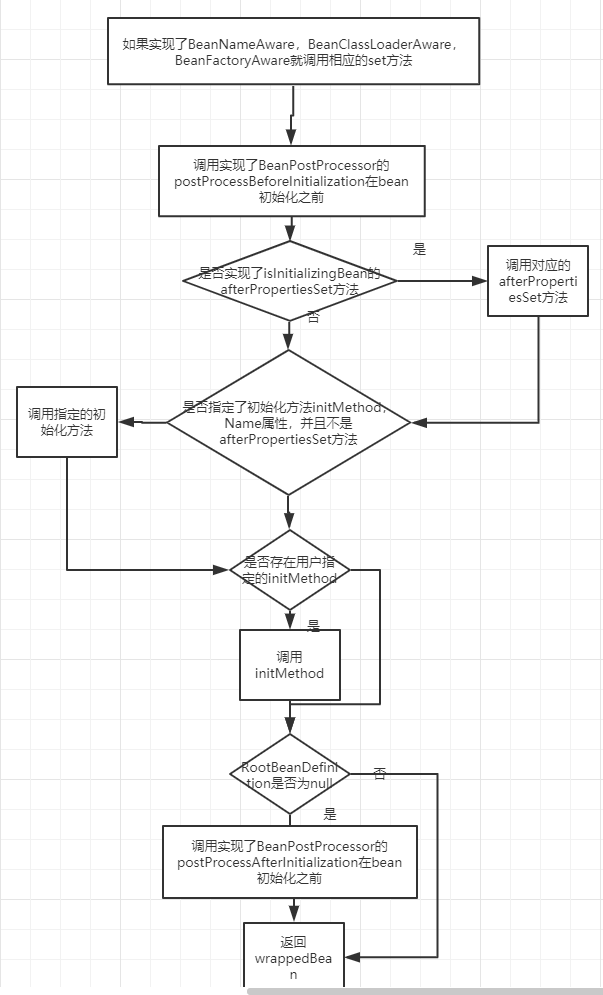
初始化Bean
同时这里根据代码跟流程图来说明
1、如果Bean实现了 BeanNameAware, BeanClassLoaderAware, BeanFactoryAware则调用对应实现的方法 。
2、Bean不为null并且bean不是合成的,如果实现了 BeanPostProcessor的 postProcessBeforeInitialization则会调用实现的 postProcessBeforeInitialization方法。在 ApplicationContextAwareProcessor类中实现了 postProcessBeforeInitialization方法。而这个类会在Spring刷新容器准备 beanFactory的时候会加进去,这里就会被调用,而调用里面会检查Bean是不是 EnvironmentAware, EmbeddedValueResolverAware, ResourceLoaderAware, ApplicationEventPublisherAware, MessageSourceAware, ApplicationContextAware的实现类。这里就会调用对应的实现方法。代码如下
1
2
3
4
5
6
7
8
9
10
11
12
13
14
15
16
17
18
19
20
21
22
23
24
25
26
27
28
29
30
31
32
33
34
35
36
37
38
39
40
41
42
43
44
45
46
47
48
49
50
51
52
53
| protected void prepareBeanFactory(ConfigurableListableBeanFactory beanFactory) {
beanFactory.setBeanClassLoader(this.getClassLoader());
beanFactory.setBeanExpressionResolver(new StandardBeanExpressionResolver(beanFactory.getBeanClassLoader()));
beanFactory.addPropertyEditorRegistrar(new ResourceEditorRegistrar(this, this.getEnvironment()));
beanFactory.addBeanPostProcessor(new ApplicationContextAwareProcessor(this));
beanFactory.ignoreDependencyInterface(ResourceLoaderAware.class);
beanFactory.ignoreDependencyInterface(ApplicationEventPublisherAware.class);
beanFactory.ignoreDependencyInterface(MessageSourceAware.class);
beanFactory.ignoreDependencyInterface(ApplicationContextAware.class);
beanFactory.ignoreDependencyInterface(EnvironmentAware.class);
beanFactory.registerResolvableDependency(BeanFactory.class, beanFactory);
beanFactory.registerResolvableDependency(ResourceLoader.class, this);
beanFactory.registerResolvableDependency(ApplicationEventPublisher.class, this);
beanFactory.registerResolvableDependency(ApplicationContext.class, this);
if (beanFactory.containsBean("loadTimeWeaver")) {
beanFactory.addBeanPostProcessor(new LoadTimeWeaverAwareProcessor(beanFactory));
beanFactory.setTempClassLoader(new ContextTypeMatchClassLoader(beanFactory.getBeanClassLoader()));
}
if (!beanFactory.containsLocalBean("environment")) {
beanFactory.registerSingleton("environment", this.getEnvironment());
}
if (!beanFactory.containsLocalBean("systemProperties")) {
beanFactory.registerSingleton("systemProperties", this.getEnvironment().getSystemProperties());
}
if (!beanFactory.containsLocalBean("systemEnvironment")) {
beanFactory.registerSingleton("systemEnvironment", this.getEnvironment().getSystemEnvironment());
}
}
public Object postProcessBeforeInitialization(final Object bean, String beanName) throws BeansException {
AccessControlContext acc = null;
if (System.getSecurityManager() != null && (bean instanceof EnvironmentAware || bean instanceof EmbeddedValueResolverAware || bean instanceof ResourceLoaderAware || bean instanceof ApplicationEventPublisherAware || bean instanceof MessageSourceAware || bean instanceof ApplicationContextAware)) {
acc = this.applicationContext.getBeanFactory().getAccessControlContext();
}
if (acc != null) {
AccessController.doPrivileged(new PrivilegedAction<Object>() {
public Object run() {
ApplicationContextAwareProcessor.this.invokeAwareInterfaces(bean);
return null;
}
}, acc);
} else {
this.invokeAwareInterfaces(bean);
}
return bean;
}
|
1、实例化Bean然后,检查是否实现了 InitializingBean的 afterPropertiesSet方法,如果实现了就会调用
2、Bean不为null并且bean不是合成的,如果实现了 BeanPostProcessor的 postProcessBeforeInitialization则会调用实现的 postProcessAfterInitialization方法。
到此创建Bean 的流程就没了,剩下的就是容器销毁的时候的了
三、destory方法跟销毁Bean
Bean在创建完毕之后会检查用户是否指定了 destroyMethodName以及是否实现了 DestructionAwareBeanPostProcessor接口的 requiresDestruction方法,如果指定了会记录下来保存在 DisposableBeanAdapter对象中并保存在bean的 disposableBeans属性中。代码在 AbstractBeanFactory的 registerDisposableBeanIfNecessary中
1
2
3
4
5
6
7
8
9
10
11
12
13
14
15
16
17
18
19
20
21
22
23
24
25
26
27
28
29
30
31
32
33
34
35
36
37
38
39
40
41
42
43
44
45
46
| protected void registerDisposableBeanIfNecessary(String beanName, Object bean, RootBeanDefinition mbd) {
AccessControlContext acc = System.getSecurityManager() != null ? this.getAccessControlContext() : null;
if (!mbd.isPrototype() && this.requiresDestruction(bean, mbd)) {
if (mbd.isSingleton()) {
this.registerDisposableBean(beanName, new DisposableBeanAdapter(bean, beanName, mbd, this.getBeanPostProcessors(), acc));
} else {
Scope scope = (Scope)this.scopes.get(mbd.getScope());
if (scope == null) {
throw new IllegalStateException("No Scope registered for scope name '" + mbd.getScope() + "'");
}
scope.registerDestructionCallback(beanName, new DisposableBeanAdapter(bean, beanName, mbd, this.getBeanPostProcessors(), acc));
}
}
}
public DisposableBeanAdapter(Object bean, String beanName, RootBeanDefinition beanDefinition, List<BeanPostProcessor> postProcessors, AccessControlContext acc) {
Assert.notNull(bean, "Disposable bean must not be null");
this.bean = bean;
this.beanName = beanName;
this.invokeDisposableBean = this.bean instanceof DisposableBean && !beanDefinition.isExternallyManagedDestroyMethod("destroy");
this.nonPublicAccessAllowed = beanDefinition.isNonPublicAccessAllowed();
this.acc = acc;
String destroyMethodName = this.inferDestroyMethodIfNecessary(bean, beanDefinition);
if (destroyMethodName != null && (!this.invokeDisposableBean || !"destroy".equals(destroyMethodName)) && !beanDefinition.isExternallyManagedDestroyMethod(destroyMethodName)) {
this.destroyMethodName = destroyMethodName;
this.destroyMethod = this.determineDestroyMethod();
if (this.destroyMethod == null) {
if (beanDefinition.isEnforceDestroyMethod()) {
throw new BeanDefinitionValidationException("Couldn't find a destroy method named '" + destroyMethodName + "' on bean with name '" + beanName + "'");
}
} else {
Class<?>[] paramTypes = this.destroyMethod.getParameterTypes();
if (paramTypes.length > 1) {
throw new BeanDefinitionValidationException("Method '" + destroyMethodName + "' of bean '" + beanName + "' has more than one parameter - not supported as destroy method");
}
if (paramTypes.length == 1 && Boolean.TYPE != paramTypes[0]) {
throw new BeanDefinitionValidationException("Method '" + destroyMethodName + "' of bean '" + beanName + "' has a non-boolean parameter - not supported as destroy method");
}
}
}
this.beanPostProcessors = this.filterPostProcessors(postProcessors, bean);
}
|
在销毁Bean的时候最后都会调用 AbstractAutowireCapableBeanFactory的 destroyBean方法。
1
2
3
| public void destroyBean(Object existingBean) {
(new DisposableBeanAdapter(existingBean, this.getBeanPostProcessors(), this.getAccessControlContext())).destroy();
}
|
这里是创建一个 DisposableBeanAdapter对象,这个对象实现了Runnable接口,在实现的 run方法中会调用实现的 DisposableBean接口的 destroy方法。并且在创建 DisposableBeanAdapter对象的时候会根据传入的bean是否实现了 DisposableBean接口来设置 invokeDisposableBean变量,这个变量表实有没有实现 DisposableBean接口
DisposableBeanAdapter.java >folded1
2
3
4
5
6
7
8
9
10
11
12
13
14
15
16
17
18
19
20
21
22
23
24
25
26
27
28
29
30
31
32
33
34
35
36
37
38
39
40
41
42
43
44
45
46
47
48
49
50
51
52
53
54
55
56
57
58
59
60
| public DisposableBeanAdapter(Object bean, List<BeanPostProcessor> postProcessors, AccessControlContext acc) {
Assert.notNull(bean, "Disposable bean must not be null");
this.bean = bean;
this.beanName = null;
this.invokeDisposableBean = this.bean instanceof DisposableBean;
this.nonPublicAccessAllowed = true;
this.acc = acc;
this.beanPostProcessors = this.filterPostProcessors(postProcessors, bean);
}
public void run() {
this.destroy();
}
public void destroy() {
if (!CollectionUtils.isEmpty(this.beanPostProcessors)) {
Iterator var1 = this.beanPostProcessors.iterator();
while(var1.hasNext()) {
DestructionAwareBeanPostProcessor processor = (DestructionAwareBeanPostProcessor)var1.next();
processor.postProcessBeforeDestruction(this.bean, this.beanName);
}
}
if (this.invokeDisposableBean) {
if (logger.isDebugEnabled()) {
logger.debug("Invoking destroy() on bean with name '" + this.beanName + "'");
}
try {
if (System.getSecurityManager() != null) {
AccessController.doPrivileged(new PrivilegedExceptionAction<Object>() {
public Object run() throws Exception {
((DisposableBean)DisposableBeanAdapter.this.bean).destroy();
return null;
}
}, this.acc);
} else {
((DisposableBean)this.bean).destroy();
}
} catch (Throwable var3) {
String msg = "Invocation of destroy method failed on bean with name '" + this.beanName + "'";
if (logger.isDebugEnabled()) {
logger.warn(msg, var3);
} else {
logger.warn(msg + ": " + var3);
}
}
}
if (this.destroyMethod != null) {
this.invokeCustomDestroyMethod(this.destroyMethod);
} else if (this.destroyMethodName != null) {
Method methodToCall = this.determineDestroyMethod();
if (methodToCall != null) {
this.invokeCustomDestroyMethod(methodToCall);
}
}
}
|
四、总结

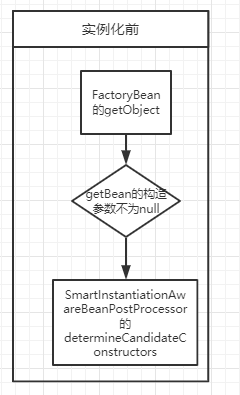
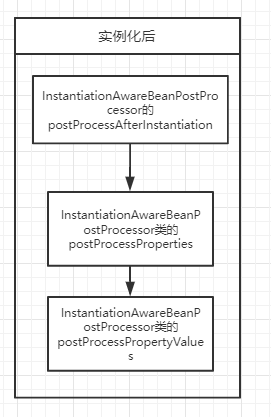
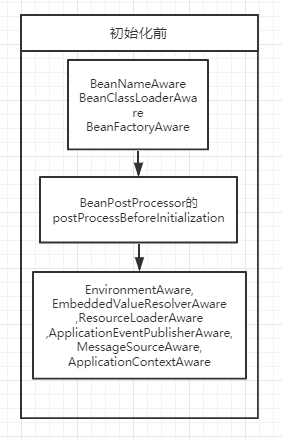

参考文章:
参考链接











